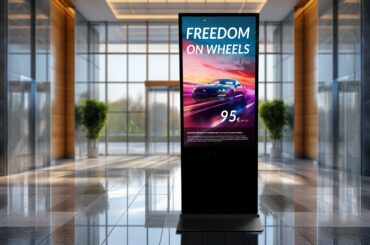The Ultimate Step-by-Step Guide
“We are drowning in information, starved for knowledge”
– John Naisbitt, Megatrends
Size matters: At least when speaking of video walls. This is of great importance when communicating memorably about brands. The following example illustrates the supported:
The cube opened in February 2013 at the University of Technology in Brisbane. The worlds’ largest multi-touch installation consists of 48 multi-touch displays, 14 HD projectors as well as 55 speakers. With a height of a 2 story building constantly changing content is presented. Daily different Information events of diverse subject areas are demonstrated on the cubes’ touch display. An interactive program, games, and competitions extend the content. Even professors of the university put the cube to use for workshops and also as a component of their lectures.
Screens Are a Major Subject for Video Walls
When speaking of a video wall realization, the preparation is the most important. A lot of points have to be considered before you get started. “How to make a video wall” white paper will assist the process and light up the essential aspects as a guide.
Let’s talk about the components that are needed in order to install a video wall just right and start with the choice of the best fit of screens in part 1.
Greater Attention with Brighter Images
Special screens need to be used on the video wall. This has different reasons. Even though from the outside it looks similar to other TVs, there are substantial technical differences. Normal TV screens are designed for the daily use of up to 8 hours. Displays that are designed for video walls are able to be operated 24/7.
In addition, there are differences in the installed power connectors, for example, safety regulations and certifications for the outside use. Another difference is the brightness of the screens: Because whoever wants to stand out in the second communication of the 21st century should be able to stand out from the floods of information. By screens in the consumer spectrum, this number is usually 300 candelas per square meter (cd/m2). Screens for video walls produce a brightness of between 500 and 700 cd/m2.
The Quantity of Screens
In the area of the video wall, two fundamental variations are differentiated. The video wall could either consist of one or be an arrangement of multiple screens.
If it is a single screen device, we are talking about a large format display. For this purpose, especially large displays will be used, which have grown to be in high demand. Currently offered are screens with display diagonal measurement of up to 98’’ (248cm).
In a classic video wall, several screens are constructed together to form a larger area. In these installations, the displays are usually assembled in sequence 2×2, 3×3, 4×4 or 5×5.
Distance Matters
In order for the picture information to be broadcasted on the integrated screen you would use processors and diverse cables.
Generally, the installations are mounted in a way that the observer can keep a significant distance from the device. Many of the displays have frames that create gaps in the image and therefore cause an optical break in the overall picture. This effect can be minimized through the distance the observer keeps to the video wall. The bigger the distance, the smaller the gaps seem.
How to measure this distance, and how to figure out which screens to pick will be discussed in the white paper you can download in part 2.
Author: Claus Hombrecher is a trusted expert and author in digital signage, technology innovation, marketing and business transformation.





